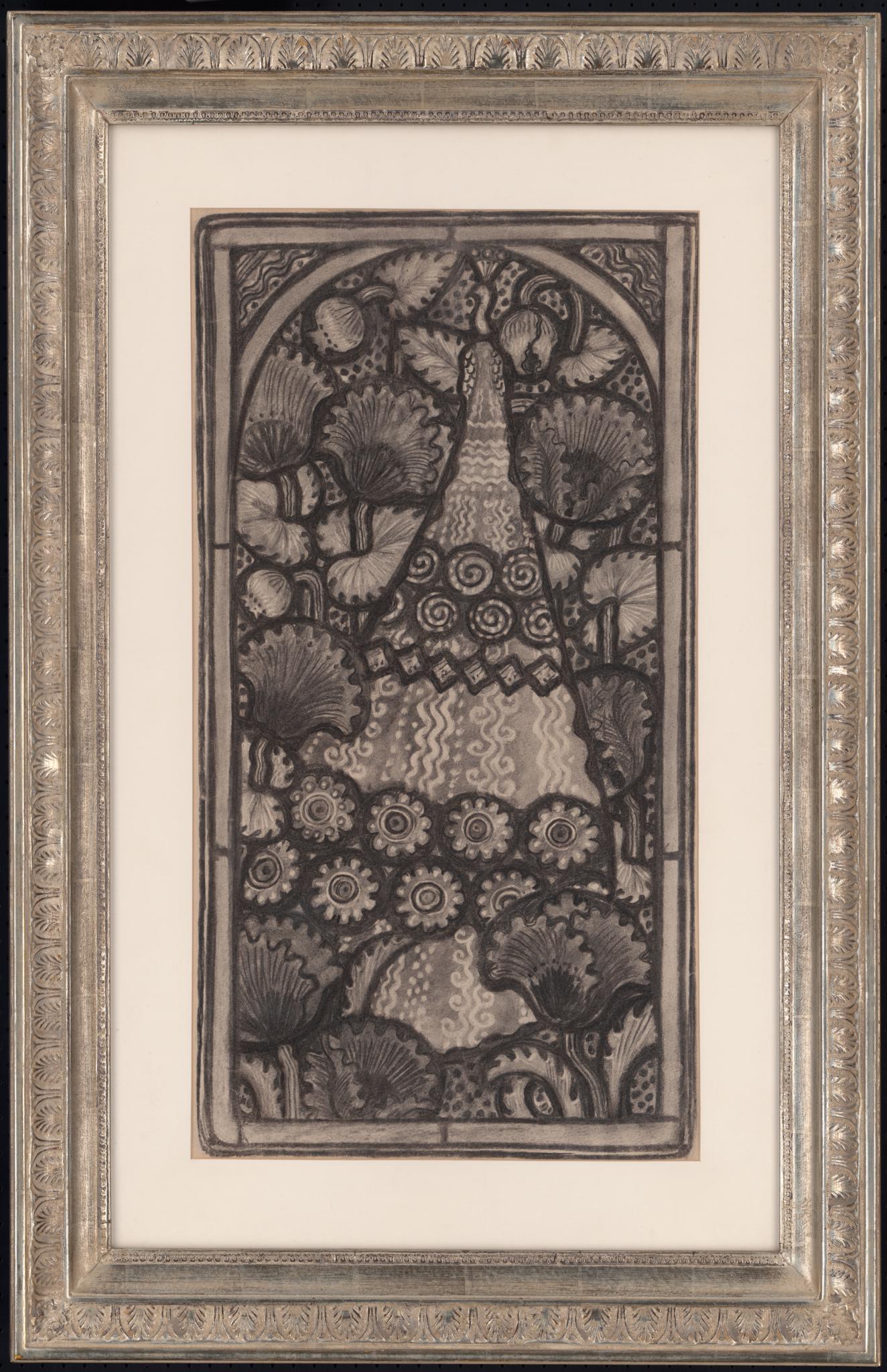This design for a stained glass window was probably made between 1897 and 1901, when the Swiss artist Augusto Giacometti (1877–1947) was in Paris to attend the classes given by Eugène Grasset (1845–1917) at the École normale d’enseignement du dessin, also known as the École Guérin (Kaiser, 1999, pp. 6–9). It was in this context that Giacometti executed his first designs for stained glass windows. In his memoirs, the artist declares: ‘Wir hatten ja in Paris, im Unterricht bei Grasset, das Technische der Glasmalerei kennengelernt. Auch hatten wir in seinem Unterricht Aufgaben von ihm erhalten, kleinere Entwürfe für Glasscheiben zu machen’ (‘In fact in Paris, during the teaching we had under Grasset, we got to know the technical aspects of stained glass. During the lessons, we were also given exercises that consisted in drawing up small designs for panels of stained glass.’) (Giacometti, 1997, p. 82). Grasset liked to confront his pupils with the practical application of his rules for ornamental composition. The young artist, originally from Grisons, was an esteemed pupil of Grasset, who commissioned Giacometti to design the title page of the second edition of his book La Plante et ses applications ornementales, publié sous la direction de E. Grasset, 2e série (1899) (Stutzer, 1991, p. 23). Giacometti was so impressed by the first edition of this book, published in 1896–1897, that he wanted to meet its author and attend his classes in Paris.
The peacock motif was very popular during the Art Nouveau period, often forming the main motif of a work. In the stained glass window La Musique – designed for a private house, produced in 1900–1901 by Gaudin’s studio, and based on a design by Eugène Grasset – the peacock is discreetly relegated to the foreground (Murray-Robertson, 1981, p. 70). The bird lends itself perfectly to the application of Eugène Grasset’s ornamental theories, as evidenced by three sketches by him in his ‘Notes de cours sur les animaux’ (‘Lecture notes on animals’) (Lepdor, 2011, p. 206). Giacometti certainly attended these lectures, and it is safe to assume that the design held at the Vitromusée Romont is a direct application of Eugène Grasset’s teaching. In one of Giacometti’s sketchbooks, a sketch dated 10 December 1897 depicts two peacocks whose tails are ornamentally inserted into a square and a rectangle, respectively (Stutzer, 1991, ill. 19, p. 21), clearly echoing Grasset’s exploratory path towards ornamental abstraction in the three sketches cited above.
In the stained glass design by Giacometti discussed here, the exotic bird is represented from behind, his tail becoming the main motif. Although the composition is not new, it nevertheless shows a novel approach, in which the plumage of the bird is rendered as a completely flat, geometrical surface, covered with motifs that we find again in the Méthode de composition ornementale par Eugène Grasset, published in 1905 in Paris in two volumes. A pastel and chalk sketch by Giacometti, probably from the same period and auctioned by Koller in Zurich on 2 December 2016 (Lot 3120, Z41 Art Suisse, see Koller Auktionen, 2016), shows clear similarities as regards the highly ornamental style of the design.
This predilection for geometric form seems to eclipse the importance of Grasset's lessons from La Plante et ses applications ornementales. However, the naturalistic rendering of the surrounding poppy flowers contrasts sharply with the abstract representation of the bird’s tail and must be interpreted as an homage to his famous teacher’s lessons.
Even though the perforated background of the arc-shaped main field of this stained glass design might be another reference to Grasset’s theories on surface ornamentation, it shows a striking similarity to Islamic stucco and glass windows, with which Grasset must have been familiar from his stay in Egypt in 1866–1867. It is not known if Giacometti knew about such windows. However, it is likely that he was aware of the detailed reproduction of Islamic stucco and glass windows published in L’Art arabe d’après les monuments du Kaire of 1869–1877 by Émile Prisse d’Avennes (1807–1879) (IG_31, IG_32, IG_42, IG_43). The richly illustrated book must have been familiar to the broader Parisian public after having been presented at the 1878 Exposition Universelle (Prisse d’Avennes (son), 1896, p. 53).
The characteristics of a stained glass design are clearly visible in the work discussed here: the lead lines are well defined; the motif is enclosed in a rectangular frame composed of transparent glass. It is not known whether a stained glass window was made from this design, nor do we know if a technique similar to the windows of Moser’s fumoir (IG_64), which were executed in 1908 in Paris by August Bruin, was intended. To imitate the perforated surface of the stucco panel of Islamic windows, Bruin used white opalescent glass, from which holes were etched out at regular intervals.
In his memoirs, Augusto Giacometti mentions the existence of stained glass windows made in Paris based on his designs, but he himself does not know the location, having left the city before they were executed (Giacometti, 1997, p. 50; Kaiser, 1999, p. 76). Thanks to a study of the records of the Gaudin studio, Jean-François Luneau was able to locate these windows in the church of Saint-Honoré-d’Eylau, where they were installed in 1902 (Luneau, 2006, p. 392). These four Parisian windows, in which the influence of Grasset’s teaching is evident in the interest in ornament, are stylistically and above all technically distinct from Giacometti’s later stained glass windows, for which the artist was heavily involved at the production stage, collaborating intensively with the studio. Moreover, this design for a stained glass window with a peacock, perhaps Giacometti’s first such design, also stands apart from his later designs, which were mostly executed in coloured pastel on black or dark paper without showing the lead lines, as the artist focused initially on the colour effects (Kaiser, 1999, pp. 46, 49).
